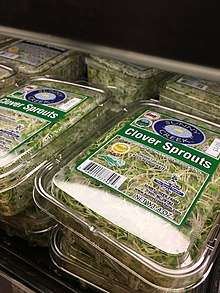Trifolium incarnatum
Trifolium incarnatum, known as crimson clover[1] or Italian clover, is a species of clover in the family Fabaceae, native to most of Europe. It has been introduced to other areas, including the United States and Japan. The species name incarnatum means "blood red".
| Crimson clover | |
|---|---|
_%E3%83%99%E3%83%8B%E3%83%90%E3%83%8A%E3%83%84%E3%83%A1%E3%82%AF%E3%82%B5_DSCF0062.jpg) | |
| Scientific classification | |
| Kingdom: | Plantae |
| Clade: | Tracheophytes |
| Clade: | Angiosperms |
| Clade: | Eudicots |
| Clade: | Rosids |
| Order: | Fabales |
| Family: | Fabaceae |
| Genus: | Trifolium |
| Species: | T. incarnatum |
| Binomial name | |
| Trifolium incarnatum | |
This upright annual herb grows to 20–50 cm (8-20") tall, unbranched or branched only at the base. The leaves are trifoliate with a long petiole, each leaflet hairy, 8–16 mm across, with a truncated or bilobed apex. The flowers are produced throughout the spring and summer, rich red or crimson, congested on an elongated spike inflorescence 3–5 cm tall and 1.5 cm broad; the individual flowers are up to 10–13 mm long and have five petals. The banner of each flower does not sit upright, but folds forward.
Uses
Crimson clover is commonly used in agriculture as a nitrogen-fixing cover crop[2]. The plant uses associations with Rhizobia bacteria to fix nitrogen[2]. The plant is widely grown as a protein-rich forage crop for cattle and other livestock, and is suitable to be made into hay. It is commonly grazed by domestic and wild ruminants.[3] It is often used for roadside erosion control, as well as beautification, however it tends to eliminate all other desirable spring and early-summer species of native vegetation in the area where it is planted.

Crimson clover's flowers and the sprouts, which are visually and gustatorily similar to alfalfa sprouts are edible[4][5]. They can be added as an ingredient in salads, sandwiches, and other dishes, made into tisanes, and can be dried and ground into flour.[5] 100 grams of crimson clover sprouts contains 23 calories, 4g of protein, 2g of fiber, and provides 38 percent of the RDI of vitamin K, as well as 14 percent of the RDI of vitamin C.[4] It has extremely small amounts of calcium, iron, phosphorus, zinc, selenium and magnesium.[4] Like all raw eaten sprouts, they possess the risk of Escherichia coli, Salmonella, Listeria, and Bacillus cereus contamination.[6] However, many reputable facilities in the United States attempt to regulate and test these crops for such bacteria.[7]

Cultivation
It is sown as quickly as possible after the removal of a grain crop at the rate of 20–22 kg/ha. It is found to succeed better when only the surface of the soil is stirred by the scarifier and harrow than when a plowing is given. It grows rapidly in spring, and yields an abundant crop of greenery. Only one cutting, however, can be obtained, as it does not shoot again after being mown.
References and external links
- "Trifolium incarnatum". Natural Resources Conservation Service PLANTS Database. USDA. Retrieved 15 December 2015.
- Young-Mathews, Annie (February 2013). "Plant guide for crimson clover (Trifolium incarnatum)" (PDF). USDA. Retrieved May 21, 2019.
- Heuzé V., Tran G., Maxin G., 2016. Crimson clover (Trifolium incarnatum). Feedipedia, a programme by INRA, CIRAD, AFZ and FAO. https://www.feedipedia.org/node/247 Last updated on April 19, 2016, 11:33
- "Health Benefits of Clover Sprouts". LIVESTRONG.COM. Retrieved 2019-02-25.
- "Crimson Clover: Pictures, Flowers, Leaves and Identification | Trifolium incarnatum". www.ediblewildfood.com. Retrieved 2019-02-25.
- Meathead (2011-06-11). "Why Raw Sprouts May be the Riskiest Food in Your Grocery Store". Huffington Post. Retrieved 2019-02-25.
- Foodsafety.gov. "Sprouts: What You Should Know". www.foodsafety.gov. Retrieved 2019-02-28.
- Flora Europaea: Trifolium incarnatum
- Ecoflora: Trifolium incarnatum
- FAO factsheet: Trifolium incarnatum
- Ajilvsgi, Geyata. (2003). Wildflowers of Texas. Shearer Publishing, Fredericksburg, Texas (USA). ISBN 0-940672-73-1.
- Robert W. Freckmann Herbarium, University of Wisconsin Page with several photos.
- Ultrastructural details seen on the surface of a "crimson clover", Trifolium incarnatum flower petal.
| Wikimedia Commons has media related to Trifolium incarnatum. |
_%E3%83%99%E3%83%8B%E3%83%90%E3%83%8A%E3%83%84%E3%83%A1%E3%82%AF%E3%82%B5_DSCF0668.jpg)